 Jennie McDonald is the Director of Publisher Relations and Rights at Collaborative Classroom, leading the organization’s engagement with trade publishers and authors. She is part of the team that annually reviews and refreshes our classroom libraries, and she works closely with our developers on the integration of children’s literature into the curricula. As part of these efforts, over a thousand books cross her desk every year.
Jennie McDonald is the Director of Publisher Relations and Rights at Collaborative Classroom, leading the organization’s engagement with trade publishers and authors. She is part of the team that annually reviews and refreshes our classroom libraries, and she works closely with our developers on the integration of children’s literature into the curricula. As part of these efforts, over a thousand books cross her desk every year.
Jennie has also developed a series of author interviews to support teachers and students who wish to learn more about writers and writing, and she spearheaded the first full-scale diversity review of books in our literacy programs.
Let’s talk about literature in the classroom: the books that children choose for independent reading and the books that teachers read aloud to the entire class.
At Collaborative Classroom, we know how much the stories in these books matter for learning, identity, and connection. And through our work selecting authentic children’s literature for our literacy and SEL curricula, we know how hard it can be to find books that reflect the full range of human experiences. But finding these books is exactly what we must do, because, as Chimamanda Ngozi Adichie says, “The consequence of the single story is this: It robs people of dignity. It makes recognition of our equal humanity difficult. It emphasizes how we are different rather than how we are similar.”[1]
“[W]e know how hard it can be to find books that reflect the full range of human experiences. But finding these books is exactly what we must do, because, as Chimamanda Ngozi Adichie says, ‘The consequence of the single story is this: It robs people of dignity. It makes recognition of our equal humanity difficult. It emphasizes how we are different rather than how we are similar.”
So how do we begin to expand the kinds of stories we offer to students? What’s the best way to approach and embrace the review and selection of the literature we use in our schools? Should we simply throw out the old and bring in the new? Where do we find the books we need to fill in the gaps, and how do we broaden our own perspectives when assessing them? And what if we get it wrong?
In this piece, I’ll address these questions and share some of the best practices that we’ve developed in recent years at Collaborative Classroom—practices that we are constantly revisiting and refining.
The Urgency of “Windows, Mirrors, and Sliding Glass Doors,” More Than Thirty Years On
Before we dive in, let’s step back and reflect on the big picture. It’s important to remember that most adults in the United States spent their formative years in elementary school classrooms. Those classrooms often serve as our introduction to community outside the family. They are the places where we develop much of our capacity for empathy—or the lack thereof—that each of us carries throughout our lives.
The experiences we have and the stories we hear in those classrooms can be transformative. As we reflect, we return again and again to the seminal insight of Professor Rudine Sims Bishop:
“Books are sometimes windows, offering views of worlds that may be real or imagined, familiar or strange. These windows are also sliding glass doors, and readers have only to walk through in imagination to become part of whatever world has been created and recreated by the author. When lighting conditions are just right, however, a window can also be a mirror. Literature transforms human experience and reflects it back to us, and in that reflection we can see our own lives and experiences as part of the larger human experience. Reading, then, becomes a means of self-affirmation, and readers often seek their mirrors in books.”[2]
Although Bishop’s words have been quoted countless times, they remain deeply resonant and deserve to be reread and pondered in their entirety. Over three decades have passed since she wrote them—for me (and for many readers), that only increases their urgency. Why is it taking us so long to provide true richness and diversity in our classroom literature so that all students can see their stories reflected?
Reckoning with the Limitations of Publishing and Education
Sadly, one reason is that inclusive, authentic books, while increasingly available, are still hard to find. The number of children’s books that are by and about historically marginalized communities continues to expand, but we are not yet anywhere near where we need to be.
According to the Cooperative Children’s Book Center (CCBC) 2019 annual review,[3] “the number of books featuring BIPOC (Black, Indigenous, People of Color) protagonists lags far behind the number of books with White main characters—or even those with animals or other characters. Taken together, books about White children, talking bears, trucks, monsters, potatoes, etc. represent nearly three quarters (71 percent) of children’s and young adult books published in 2019.”[4] This means that overall, the books available for use in classroom libraries and lessons are pretty homogenous, when it comes to race and ethnicity.
We also need to acknowledge the reality of US public education, which was generally oriented toward a narrow swath of society and, in fact, resisted full participation by all children in the country for hundreds of years.[5] Through their purchase of children’s books, these same schools influence publishers’ decisions about what to bring to market. In the past, publishers have disingenuously complained that people of color “don’t buy books.” Both that statement and the onus of responsibility need to be flipped: publishers must bring forth books by and about marginalized communities, and those books will find an enthusiastic audience as all readers discover them.
Best Practices for Meaningful Change in Our Classroom Literature
We know that providing broad representation in the books in our programs and libraries is not a panacea; it will not fix the structural weaknesses in education. However, the use of more inclusive literature does contribute to the creation of classroom communities that are better suited to supporting culturally responsive teaching—which is, in turn, a critical tool in building educational equity.[6]
So how do we make meaningful change in classroom literature? Here are some best practices and key considerations that have guided our own ongoing efforts at Collaborative Classroom.
Practice #1: Analyze and Collect Data About Your Current Collection
Begin by taking a careful look at the books in your collection right now. Study your shelves and the texts in your lessons and collect data in a systematic way. I highly recommend inviting colleagues to collaborate on this work with you. In your analysis, ask questions such as:
- How many books are about characters from marginalized groups, e.g., Black, Indigenous, Latinx, Asian American, and others? (We try to follow the CCBC approach to these categories.)[7]
- How many books have LGBTQ representation?
- What is the gender breakdown among characters? How is gender presented?
- Where are the stories set?
- What is the socio-economic status of the characters?
- Who in the story has power or agency?
This initial step is critical. As tempting as it is to immediately begin identifying new books to enrich your classroom library, I can’t emphasize enough how important it is to first collect data so that you can see clearly where reality is falling short of your aspirations for an inclusive library. This is the perfect time to identify your blind spots.
Practice #2: Look Out for Stereotypes in Representation
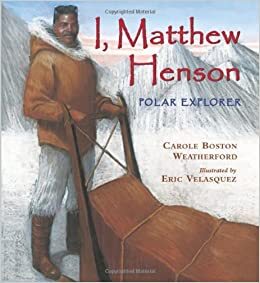
I, Matthew Henson: Polar Explorer by Carole Boston Weatherford
Be alert to the stereotypes in the representation you do find. Perhaps your classroom library contains a wealth of wonderful books about African American figures in sports, civil rights, and music. But where are the stories about Black artists, explorers, and astronauts? Yes, we want students to read about Martin Luther King, Jr., Ella Fitzgerald, and LeBron James, or about Jackie Robinson and Simone Biles, and we also want to introduce them to Jacob Lawrence, Matthew Henson, and Mae Jemison.
Practice #3: Reflect on the Underlying Themes
Reflect and look beneath the surface of the data you are collecting. Pause when you read that beautifully written book about, say, a recent Latin American immigrant to the United States who, along with his grandson, makes a major mistake in a gardening job due to a language barrier and the inexperience and youth of the grandson, and the man who hired them helps them avoid disaster because he recognizes their moral fortitude. Does this story reinforce a “White savior” theme that focuses on the White person’s action and perhaps unintentionally belittles or infantilizes the other characters’ actions? How will the Latinx students feel if that’s their only mirror in the classroom? What ideas will the non-Latinx students take from this single story?
Practice #4: Pay Attention to the Collective Message
Watch for the messages that books send as a group: you may have six out of ten books that are primarily about characters of color—yet all but one have a major theme of financial struggle. Where are the middle-class African Americans, the Native Americans living in our cities right now, the Asian Americans who don’t do origami or fly kites?
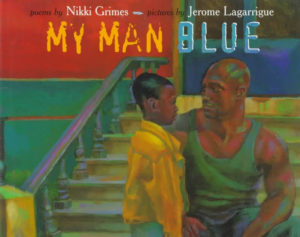
My Man Blue by Nikki Grimes
As Adichie says, “the problem with stereotypes is not that they are untrue, but that they are incomplete. They make one story become the only story.”[8] The White students in the class have the privilege of seeing themselves as individuals in so many different roles in life—good, bad, powerful, vulnerable—so they are not limited by single stories of their race. This has an impact.
A recent experience in one of our classrooms crystalized this kind of impact: when reading My Man Blue by Nikki Grimes, an African American boy whispered in poignant relief, “Finally … we are not bad … the Black guys are always the bad ones.” Children take it all in; stereotypes hurt and hinder.
Practice #5: Consider Authors, Illustrators, and Authenticity
Take a closer look at who has written the books in your collection. Who illustrates them? Whose perspective is lifted up? What experiences have shaped the perspective of the story being told? The #OwnVoices movement highlights an important factor in the march toward greater diversity in children’s literature. It’s not just what is being represented, but by whom.
This does not mean that authors should write only about their own lived experiences. That undermines the creative spirit and limits every artist. However, it does mean that when you’re considering a book about someone from a marginalized group, and the author is not a part of the group, take a closer look: did the writer do their research and make it clear that they did so? Does this book on your shelf take space from another on the same topic written by someone who may bring more authenticity to the story?
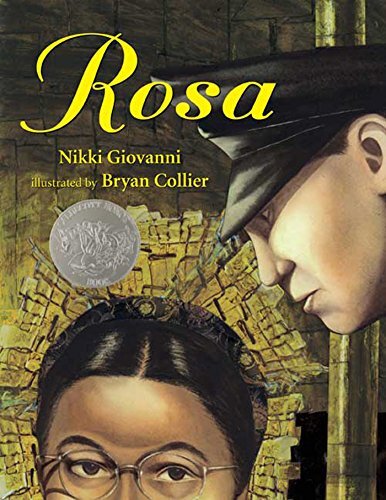
Rosa by Nikki Giovanni
For example, in our work at Collaborative Classroom, we replaced an older book on Rosa Parks by David Adler with a more recently published book about Parks written by Nikki Giovanni. It wasn’t only the newer copyright we preferred, it was the holistic approach, the sense of Rosa’s agency, and her supportive community that Giovanni provided. Ms. Parks didn’t just burst into the scene on that bus and into history, she was already part of something else—a circle of coworkers, family, friends, and engaged activists. She was three-dimensional.
In one of our diversity reviews, I noticed a nonfiction book about South Africa that opened with the line: “Imagine what it would feel like to live in a country where you are treated differently because of the color of your skin.” Who is that book written for, what realities does it overlook? How might that book begin if it had been written from the perspective of an African American writer who has been treated differently their whole life in this very country? We always think carefully about who the author is and what lens they bring to the topic. We also seek out validation from trusted sources[9] such as sites like The Brown Bookshelf, Social Justice Books, and many others, or colleagues who are closer to the content than we are.
Practice #6: Don’t Overlook Visual Representation
In your review, another area to pay close attention to is visual representation, particularly in nonfiction. I’ve seen books on transportation that show modern modes of travel (airplanes, fast trains, cars) in western European or US locations and only present bikes, carts, rickety buses, and rowboats in countries with people of color; or books on music that show an Asian American girl playing violin, an African American man with a sax, and the White man conducting (leading). Such images flatten the stories of these people and reinforce stereotypes, limiting our students’ understanding of the world and, ultimately, their place in it.
In an interview with Collaborative Classroom, author and illustrator Juana Martinez-Neal had this to say about illustration in children’s books: “I believe illustration is an extension of an illustrator’s life. We paint what we know. If we have friends of different sizes, genders, beliefs, and abilities, it’s very easy to include them in our books. Every character in my books is someone I know and love. I find it very problematic to just draw a character and paint the skin a certain color. If this happens, we are just filling in color. If this happens, we are losing the layers that make us unique and interesting.”[10]
“I believe illustration is an extension of an illustrator’s life. We paint what we know. If we have friends of different sizes, genders, beliefs, and abilities, it’s very easy to include them in our books. Every character in my books is someone I know and love. I find it very problematic to just draw a character and paint the skin a certain color. If this happens, we are just filling in color. If this happens, we are losing the layers that make us unique and interesting.” –Juana Martinez-Neal
Practice #7: Welcome New and Global Perspectives
To increase students’ connection to the world, it sometimes helps to pause and reconsider our very approach to content areas in curriculum and literature. For example, we’re striving to include nonfiction that is far more global than it was in the past to help students understand the breadth of the world we live in.
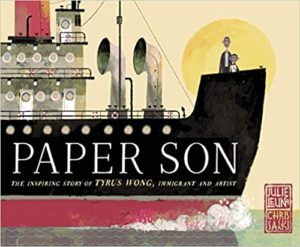
Paper Son: The Inspiring Story of Tyrus Wong, Immigrant and Artist by Julie Leung
We’re also reconsidering our approach to common themes such as “exploration” and “invention” and “art” to bring more experiences into the classroom than those that have historically been labeled as such (Columbus, Benjamin Franklin, Michelangelo), and that are often only possible with a certain amount of power and resources.
I’m not suggesting we get rid of the well known stories of important historical figures, but that we add to them and offer a fuller picture of what it means to explore, invent, or create great art. In our Being a Reader program, we hope that texts on mountaineer Junko Tabei, inventor Lonnie Johnson, animator Tyrus Wong, and librarian Pura Belpré provide a window into the wider world as well as into the internal motivations that inspired these people to do extraordinary things in their lives. Showcasing new perspectives and experiences can only help tap into students’ innate curiosity, wonder, and creativity and make these themes more accessible.
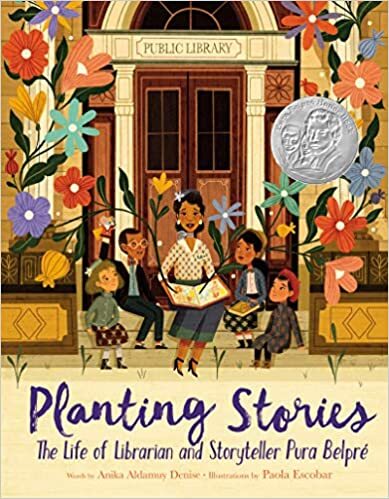
Planting Stories: The Life of Librarian and Storyteller Pura Belpré by Anika Aldamuy Denise
Practice #8: Make the Work Visible
When you evaluate your classroom library, supplement your curriculum, and choose your read-alouds with heightened sensitivity to representation, tell people around you what you are doing and why. Make your commitment to this work known—bring it into the conversations you have at home and at school. Articulate why the diversity of literature in the classroom matters and what role it plays in supporting literacy. Say it out loud.
Try not to shy away from uncomfortable conversations. I’ve tried to employ this at Collaborative Classroom: our decision to drop or select books because of representation is good for the students, and if I tell the publishers exactly why we reached that decision, it’s also helping to change publishing itself. I want our partners to know that they are gaining a license or a sale because of the breadth of representation in their title. We want our investment in these books to be noticed.
Practice #9: Suspend Judgment and Focus on the Learning
At the beginning of this blog I asked: what if we get it wrong? I should have said: we will get it wrong. So let’s not spend valuable time judging ourselves or others for mistakes. As Madeline Tyner of the CCBC said – “we are still learning as we do this work how best to do this work.” [11]
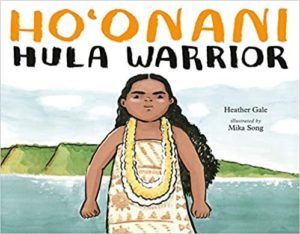
Ho’onani: Hula Warrior by Heather Gale and Mika Song
At Collaborative Classroom we apply what we learn and move on, trying to keep our focus on the goal, not on us. Our programs are grounded in authentic children’s literature and we are dedicated to educational equity; therefore we continuously explore the topic of diverse literature for students, and we understand how important it is that our book review and selection practices change over time.
Practice #10: Consider Your Personal Journey
We must also be committed to the ongoing personal and organizational transformation that comes with the territory so that we are not just checking boxes. Like learning itself, change and growth that last start within.
At Collaborative Classroom this has meant that as we’ve worked to expand our students’ horizons and perspectives, we’ve also learned to expand our own. Time and again I turn to resources[12] such as American Indians in Children’s Literature, Africa Access, and the many American Library Association awards (Coretta Scott King, Pura Belpré, etc.) for book ideas and reviews. I’ve sought multiple viewpoints inside and outside the organization and listened carefully to others—especially when I disagreed with them.
“In whatever ways are available to you, expand your personal sphere. Consider taking stock of what books are on your shelves at home—are the authors all like you? If so, make a conscious decision to branch out. Who directs and acts in the movies you watch? Whose Facebook, Twitter, and Instagram accounts do you follow?”
In whatever ways are available to you, expand your personal sphere. Consider taking stock of what books are on your shelves at home—are the authors all like you? If so, make a conscious decision to branch out. Who directs and acts in the movies you watch? Whose Facebook, Twitter, and Instagram accounts do you follow?
To paraphrase educator Chad Everett (at an ILA 2019 morning keynote): “Who that teacher is outside of the classroom is who she is inside of it.” This struck me and many others sipping coffee in the packed room: if my life is narrowly defined outside of work or school, it will be inside of it too. As educators, we have such influence over the lives of students, which brings to mind Jacqueline Woodson’s comment about teachers: “They [teachers] see us. Brilliance is passion recognized. For some of us the passion gets shaped into brilliance. And some of us never get seen.”[13]
Some students never get seen, or seen clearly. How are their lives altered and the world poorer for that loss? If we are committed to this work, we need to improve our vision. You may be far along on your personal path in this regard, or you may be just starting. You may be part of the mainstream culture in this country or part of a marginalized group. I don’t know. I do know that while we are all on different paths, we are striving toward shared goals.
“Teachers, as well as books, open doors. What an incredible opportunity our work presents: by reimagining classroom literature, educators have the power to further literacy, create community, and transform lives.”
Teachers, as well as books, open doors. What an incredible opportunity our work presents: by reimagining classroom literature, educators have the power to further literacy, create community, and transform lives.
Just as publishers have the responsibility to reexamine and diversify the authors and books they bring into print, we have a responsibility to bring those books and voices into the classroom and into our hearts and minds. This work—creating an environment in which curricula, teachers, and books represent and reach every student—is ongoing, life-changing, and joyous.
***
If you’ve enjoyed this blog post, you may enjoy our related professional learning webinar, “Inclusive Texts Matter: A Roundtable Discussion about Reimagining Classroom Libraries and Lessons.”
[1] Chimamanda Ngozi Adichie, “The Danger of a Single Story,” filmed in July 2009, TEDGlobal Video, https://www.ted.com/talks/chimamanda_ngozi_adichie_the_danger_of_a_single_story/transcript?language=en#t-812953.
[2] Rudine Sims Bishop, “Mirrors, Windows, and Sliding Glass Doors,” Collected Perspectives: Choosing and Using Books for the Classroom, vol. 6, no. 3 (Summer 1990).
[3] Data on books by and about Black, Indigenous and People of Color published for children and teens compiled by the Cooperative Children’s Book Center, School of Education, University of Wisconsin-Madison, https://ccbc.education.wisc.edu/literature-resources/ccbc-diversity-statistics/books-by-about-poc-fnn/.
[4] Tyner, Madeline. “The Numbers are In: 2019 CCBC Diversity Statistics.” CCBlogC, Cooperative Children’s Book Center, June 2020, http://ccblogc.blogspot.com/2020/06/the-numbers-are-in-2019-ccbc-diversity.html.
[5] Noliwe Rooks, Cutting School: The Segrenomics of American Education (New York: The New Press, 2017).
[6] According to Zaretta Hammond’s Distinctions of Equity, educational equity has three pillars, one of which is multiculturalism that includes the diverse literature that is the subject of this blog; the other pillars are culturally responsive teaching and social justice education: https://www.collaborativeclassroom.org/blog/a-conversation-about-instructional-equity-with-zaretta-hammond-part-1/.
[7] “Diversity Statistics FAQs,” CCBC Diversity Statistics, Cooperative Children’s Book Center, https://ccbc.education.wisc.edu/literature-resources/ccbc-diversity-statistics/diversity-statistics-faqs/.
[8] Chimamanda Ngozi Adichie, “The Danger of a Single Story,” filmed in July 2009, TEDGlobal Video, https://www.ted.com/talks/chimamanda_ngozi_adichie_the_danger_of_a_single_story/transcript?language=en#t-812953.
[9] Center for the Collaborative Classroom, “Resources to help you build an inclusive classroom library,” 2020. https://www.collaborativeclassroom.org/app/uploads/2020/11/MKT-5094_Inclusive_Classroom_Library_Resources_flyer.pdf
[10] McDonald, Jennie. “An Interview with Juana Martinez-Neal.” Center for the Collaborative Classroom. (Blog). November, 2021.
[11] Tyner, Madeline. “The Numbers are In: 2019 CCBC Diversity Statistics.” CCBlogC, Cooperative Children’s Book Center, June 2020, http://ccblogc.blogspot.com/2020/06/the-numbers-are-in-2019-ccbc-diversity.html
[12] Center for the Collaborative Classroom, “Resources to help you build an inclusive classroom library,” 2020. https://www.collaborativeclassroom.org/app/uploads/2020/11/MKT-5094_Inclusive_Classroom_Library_Resources_flyer.pdf
[13] Jacqueline Woodson, “An Evening with Jacqueline Woodson,” Cubberley Lecture 2017, Stanford Graduate School of Education, May 2017, https://youtu.be/e1s2S1awCo4.
